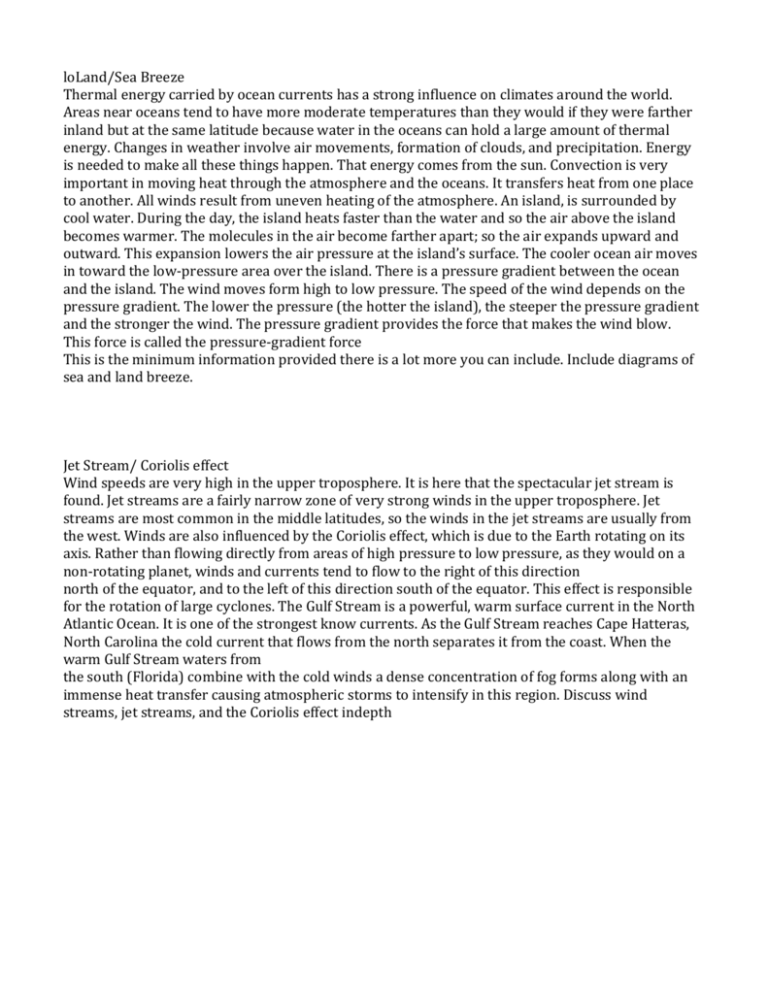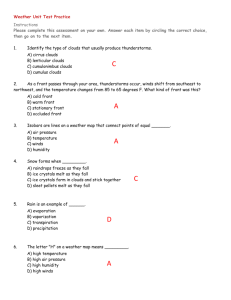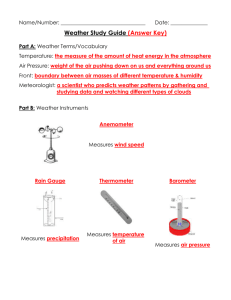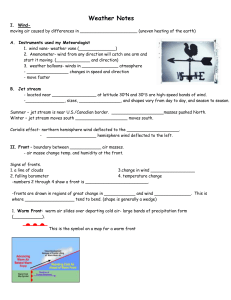loLand/Sea Breeze Thermal energy carried by ocean currents has a
advertisement

loLand/Sea Breeze Thermal energy carried by ocean currents has a strong influence on climates around the world. Areas near oceans tend to have more moderate temperatures than they would if they were farther inland but at the same latitude because water in the oceans can hold a large amount of thermal energy. Changes in weather involve air movements, formation of clouds, and precipitation. Energy is needed to make all these things happen. That energy comes from the sun. Convection is very important in moving heat through the atmosphere and the oceans. It transfers heat from one place to another. All winds result from uneven heating of the atmosphere. An island, is surrounded by cool water. During the day, the island heats faster than the water and so the air above the island becomes warmer. The molecules in the air become farther apart; so the air expands upward and outward. This expansion lowers the air pressure at the island’s surface. The cooler ocean air moves in toward the low-pressure area over the island. There is a pressure gradient between the ocean and the island. The wind moves form high to low pressure. The speed of the wind depends on the pressure gradient. The lower the pressure (the hotter the island), the steeper the pressure gradient and the stronger the wind. The pressure gradient provides the force that makes the wind blow. This force is called the pressure-gradient force This is the minimum information provided there is a lot more you can include. Include diagrams of sea and land breeze. Jet Stream/ Coriolis effect Wind speeds are very high in the upper troposphere. It is here that the spectacular jet stream is found. Jet streams are a fairly narrow zone of very strong winds in the upper troposphere. Jet streams are most common in the middle latitudes, so the winds in the jet streams are usually from the west. Winds are also influenced by the Coriolis effect, which is due to the Earth rotating on its axis. Rather than flowing directly from areas of high pressure to low pressure, as they would on a non-rotating planet, winds and currents tend to flow to the right of this direction north of the equator, and to the left of this direction south of the equator. This effect is responsible for the rotation of large cyclones. The Gulf Stream is a powerful, warm surface current in the North Atlantic Ocean. It is one of the strongest know currents. As the Gulf Stream reaches Cape Hatteras, North Carolina the cold current that flows from the north separates it from the coast. When the warm Gulf Stream waters from the south (Florida) combine with the cold winds a dense concentration of fog forms along with an immense heat transfer causing atmospheric storms to intensify in this region. Discuss wind streams, jet streams, and the Coriolis effect indepth Weather maps/ predicting weather Rain, snow, thunderstorms, lightning, and even dust storms are part of the weather. Measurements of temperature, air pressure, wind speed and direction, and the amount of moisture in the air are also included in a description of the weather. Weather is studied and predicted by scientists called Meteorologists. The science of meteorology is the study of the entire atmosphere, including the weather. To understand and predict the weather, meteorologist must first understand how the atmosphere heats and cools, how clouds form and produce rain, and what makes the wind blow.The earth has a variety of climates, defined by average temperature, precipitation, humidity, air pressure, and wind, over time in a particular place. Weather forecasting is an attempt to make accurate predictions of future weather. The accuracy of weather prediction is improving as technology advances. A weather map is useful for making predictions. Weather maps usually show precipitation, wind direction, temperature, cloud cover, high or low pressure, cold and warm fronts, stationary and occluded fronts. Weather systems generally move from west to east across the USA. Long rang weather forecasting is more difficult than short-range weather predictions. Technology has greatly influenced the ease and accuracy of making weather predictions. Weather data at thousands of locations can be gathered instantaneously and applied to weather prediction models to produce weather maps. A cold front is the leading edge of a cooler air mass of air, replacing at ground level a warmer mass of air. The cooler, denser air wedges under the less-dense warmer air, lifting it. The upward motion causes lowered pressure along the cold front and can cause the formation of a narrow line of showers and thunderstorms when enough moisture is present. On weather maps, the surface position of the cold front is marked with the symbol of a blue line of triangles/spike pointing in the direction it is traveling. Cold fronts can move up to twice as fast as warm front and can produce sharper changes in the weather. Cold fronts are usually associated with an area of high pressure. A warm front is the leading edge of a warm air mass that displaces colder air, bringing a temperature increase and heavy rain where the front makes contact with the ground. On a weather map a warm front is represented by a solid line with semicircles pointing towards the colder air and in the direction of the movement. On a colored weather map, a warm front is drawn with a solid red line. A picture and explanations of how to read a weather map must be included (think interactive), as well as how this weather is predicted through low pressure/ high pressure etc. What a meteorologist must do in order to predict the weather. Tornado An air mass is a large section of the lower troposphere that has the same weather throughout. Air masses can form over continents, icecaps or the ocean. Air masses are controlled by patterns of heating and cooling over large areas of the Earth’s surface. Changes in air pressure readings indicate the passing of high and low pressure systems. Differences in air pressure cause Earth’s winds and weather changes. Storms are natural disturbances in the atmosphere that involve air pressure, clouds, precipitation, and strong winds. The major types of storms are thunderstorms, hurricanes, tornadoes, and winter storms. Each type has its own characteristics and dangers. Tornadoes are violently whirling winds sometimes visible as a funnel-shaped cloud. They are produced by severe thunderstorms. Spiraling high winds and extremely low pressure are the unique features of tornadoes This is the minimum information provided there is a lot more you can include. Thunderstorm An air mass is a large section of the lower troposphere that has the same weather throughout. Air masses can form over continents, icecaps or the ocean. Air masses are controlled by patterns of heating and cooling over large areas of the Earth’s surface. Changes in air pressure readings indicate the passing of high and low pressure systems. Differences in air pressure cause Earth’s winds and weather changes. Storms are natural disturbances in the atmosphere that involve air pressure, clouds, precipitation, and strong winds. The major types of storms are thunderstorms, hurricanes, tornadoes, and winter storms. Each type has its own characteristics and dangers. Thunderstorms are known as electrical storms. A thunderstorm is characterized by the presence of lightning and thunder. They are produced rapidly when rising air causes cumulus clouds to build upward into a thunderhead. The cloud type associated with thunderstorms are cumulonimbus. Thunderstorms are usually accompanied by strong winds, heavy rain and sometimes snow, hail or no precipitation at all. Thunderstorms are brief, intense storms that affect a small area. Weather related flooding is most often associated with hurricanes and thunderstorms This is the minimum information provided there is a lot more you can include. Hurricane An air mass is a large section of the lower troposphere that has the same weather throughout. Air masses can form over continents, icecaps or the ocean. Air masses are controlled by patterns of heating and cooling over large areas of the Earth’s surface. Changes in air pressure readings indicate the passing of high and low pressure systems. Differences in air pressure cause Earth’s winds and weather changes. Storms are natural disturbances in the atmosphere that involve air pressure, clouds, precipitation, and strong winds. The major types of storms are thunderstorms, hurricanes, tornadoes, and winter storms. Each type has its own characteristics and dangers. Hurricanes are huge, rotating storms that form over the ocean near the equator. They produce very strong winds, heavy rains, and large, powerful waves and can cause severe flooding and damage from strong winds. Floods occur when an area is inundated with water. Weather related flooding is most often associated with hurricanes and thunderstorms This is the minimum information provided there is a lot more you can include. Winter Storms An air mass is a large section of the lower troposphere that has the same weather throughout. Air masses can form over continents, icecaps or the ocean. Air masses are controlled by patterns of heating and cooling over large areas of the Earth’s surface. Changes in air pressure readings indicate the passing of high and low pressure systems. Differences in air pressure cause Earth’s winds and weather changes. Storms are natural disturbances in the atmosphere that involve air pressure, clouds, precipitation, and strong winds. The major types of storms are thunderstorms, hurricanes, tornadoes, and winter storms. Each type has its own characteristics and dangers. Winter storms are associated with quickly moving cold fronts and they can produce high winds, very low temperatures plus include blizzards, ice storms and large accumulations of snow. This is the minimum information provided there is a lot more you can include. Water Cycle Water evaporates from the surface of the earth, rises and cools, condenses into rain or snow, and falls again to the surface. The water falling on land collects in rivers and lakes, soil, and porous layers of rock, and much of it flows back into the oceans. The cycling of water in and out of the atmosphere is a significant aspect of the weather patterns on Earth. Sunlight provides the energy that evaporates water from the surface of Earth. Some of the water vapor comes from the continents, but most comes from the oceans. Winds carry the water vapor from the ocean over the continents. Part of the water vapor condenses into clouds, then falls as rain or snow. Some of the rain returns to the ocean from rivers and streams as runoff. Some seeps into the ground to become groundwater. Some returns to the air by evaporation from the ground or by transpiration from plant leaves. When runoff from the continents returns to the ocean, one turn of the water cycle is completed. Other routes are possible. For example, water that evaporates from the ocean can return to the ocean as rain. The water cycle never ends. The salt water of the ocean supplies fresh water to the continents over and over again. Weather is the state of the atmosphere at a given time and place. A complete description of the weather includes the amount and type of clouds. The Water cycle should be explained and diagramed at the minimum with explanations. Types of Clouds Clouds have three simple names: Cirrus, Stratus, and Cumulus. These three names represent the three main cloud types. There are other types of clouds that should be included that have other names. Cirrus clouds are high level clouds and due to high altitude, the water is almost frozen to form ice crystals. If there are isolated Cirrus clouds, they do not indicate any instability in the weather and may not bring rain. However, if the clouds are dense, they often indicate that a storm might be approaching. Both Stratus clouds and Cumulus clouds are low-level. Stratus clouds are layered clouds that usually bring a drizzle and there is widespread rain and in some cases ocean air. Cumulus clouds are neutral weather clouds. All the other clouds are combinations or variations of these types. Clouds should include pictures, altitudes, and what type of weather they create at the minimum. Each group of students will be given a day to teach there concept to the class. How well you teach the concept will be part of your evaluation. Lessons should be at least 10 minutes. Each Lesson Plan should at least contain: a warm-up question/ question of the day (which students should be able by the time they leave) an activity presentation of the topic wrap up activity- summary, exit slip (answer the question from the day), something the students turn in showing they understand your concept. What to turn in : 1. A visual such a poster, diagram,etc. from each group. 2. Lesson Plan (covering the above criteria) 3. Peer Evaluation 4. 2 questions students should be able to answer on a test (multiple choice, short answer, fill in the blank, etc). Think of the important concepts, and make sure your lesson teaches these concepts. 5. A rubric filled out by your group for your own project 6. A rubric for each group presenting. Creativity will earn you extra points. Going above and beyond will too. Your peers and I will be one part of your grade make it interactive and enjoyable for everyone that day. Think about the stuff you like doing in class and what you do not. Make sure you use the rubric for help, and your partner/team. There will be a group evaluation grade as well.









